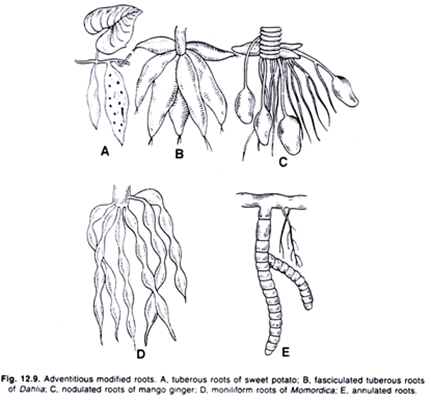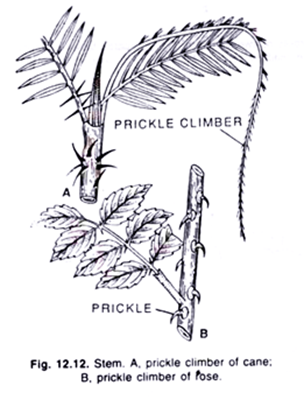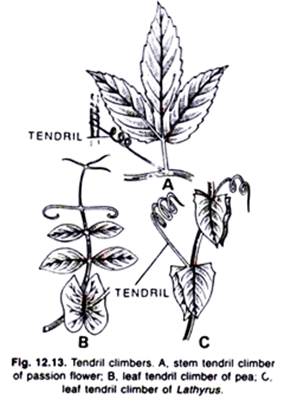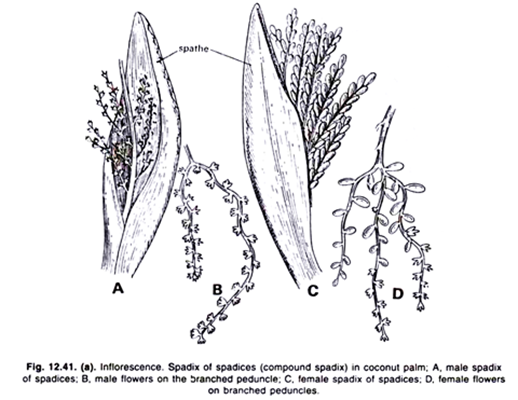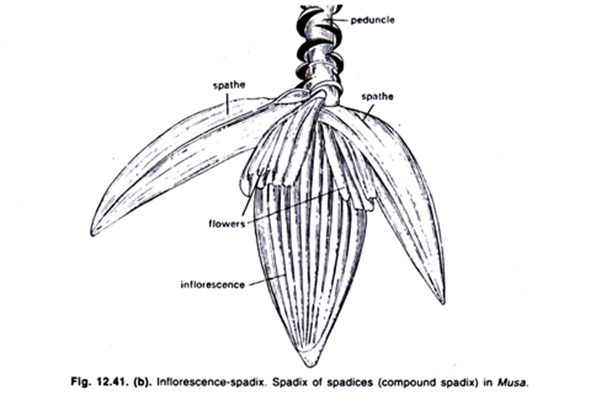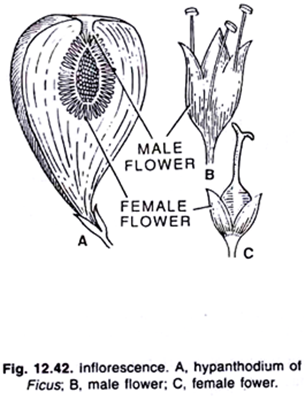Quick Notes on Angiosperms. After reading this article you will learn about: 1. Habitat of Angiosperms 2. Habit of Angiosperms 3. Root 4. Stem 5. Leaf 6. Inflorescence 7. Flower 8. Number of Sepals 9. Corolla 10. Perianth 11. Androecium 12. Gynocium 13. Fruit.
Contents
Habitat of Angiosperms:
The natural abode or locality of plant, i.e., whether cultivated as an ornamental plant, a food crop or occurs in a wild state.
Habit of Angiosperms:
Herb:
Plant with no persistent parts above ground, as distinct from shrubs and trees, e.g., Ranunculus of Ranunculaceae.
Shrub:
Perennial woody plant, typically with several stems arising from or near the ground, e.g., Capparis of Capparidaceae.
Tree:
A perennial woody plant with a single trunk, e.g., Melia of Meliaceae.
Annual:
Plant that completes its life-cycle, from seed germination to seed production, followed by death within a single season, e.g., Brassica of Cruciferae.
Biennial:
Plant that continues its growth from year to year. In herbaceous perennials serial parts die away in autumn, replaced by new shoots in the following year from underground structures, e.g., Delphinium, in woody perennials, permanent woody stems above ground from starting point for each new year’s growth, a characteristic that enables some of them to reach a large size, e.g., shrubs and trees.
Parasite:
Plant living in or on another plant (its host) from which it obtains food, e.g., Cuscuta of Convolvulaceae.
Plant attached to another plant, not growing parasitically upon it but merely using it for support, e.g., Vanda (an orchid) of Orchidaceae.
Mesophyte:
Plant growing under average conditions of water supply.
Hydrophyte:
Plant whose habitat is water or very wet places, e.g., Ranunculus aquatilis of Ranunculaceae; Neptunia oleracea of Mimosoideae.
Xerophyte:
Plant of dry habitat able to endure conditions of prolonged drought, e.g., Capparis decidua of Capparidaceae.
Saprophyte:
Plant which obtains organic matter in solution from dead and decaying tissues of plants (or animals), e.g., Monotropa.
Root of Angiosperms:
That part of vascular plants that usually grow downwards into the soil, anchoring plant and absorbing water and nutrient salts.
Tap:
Root system with a prominent main root, directed vertically downwards and bearing smaller lateral roots, e.g., most of dicots; Cajanus of Papilionatae.
Adventitious:
Root developing from part of plant other than roots, e.g., from stem or leaf cutting; of buds, developing from part of plant other than in axil of leaf, e.g., from root, most of monocots.
Branched:
Roots possessing branches.
Un-branched:
Roots without branches.
Fibrous:
A fibrous root system consists of a tuft of adventitious roots of more or less equal diameter, arising from stem base or hypocotyl and bearing smaller lateral roots, e.g., wheat, strawberry.
Prop:
Hanging aerial roots of Ficus.
Stilt:
Such roots arise from the nodes of the stem above the soil, e.g., Saccharum.
Aerial:
Hanging aerial roots, e.g., Orchids. 
Climbing:
The roots that help in climbing of plants, e.g., Tecoma, Piper, Pothos.
Respiratory:
Spongy roots, e.g., Jussiaea.
Pneumatophores:
Special root branch produced in large numbers by some vascular plants growing in water or in tidal swamps, e.g. Mangrove; grows erect, projecting into the air above and contains well developed intercellular system of air spaces in communication with atmosphere through pores on aerial portion.
Tuberous:
Irregularly swollen roots laden with starch, e.g., Ipomoea batatas of Convolvulaceae.  Parasitic:
Parasitic:
The sucking roots of parasites, e.g., Cuscuta, Dendrophthoe, Viscum, Orobanche.
Epipliytic:
Hanging aerial roots of Orchids.
Assimilatory:
The aerial roots with chlorophyll, e.g., Tinospora.
Aquatic:
The roots found in water plant. They do not possess root caps and root hairs, e.g., Pistia.
Conical:
Cone like fleshy roots, e.g., carrot.
Fusiform:
Fusiform, e.g., fleshy root of radish (Raphanus sativus of Cruciferae).
Napiform:
Napiform. e.g., fleshy root of turnip.
Fasciculated:
Clusters of fleshy roots, e.g., Asparagus.
Nodulated:
The nodules of the roots contain bacteria, e.g., Leguminous roots; Cicer, Arachis, Trifolium.
Beaded or Moniliform:
The roots possessing beaded structures, e.g., Vitis.
Annulated:
When the root has a series of ring-like swellings on its body, e.g., ipecacuanha.
Nodulose:
When the slender root becomes suddenly swollen near the apex, e.g., Curcuma amada (Am-haldi).
Stem of Angiosperms:
Normally aerial part of axis of vascular plants, bearing leaves and buds at definite positions (nodes) and reproductive structures, e.g., flowers.
Erect:
Rigid, strong and upright stem.
Prostrate:
Trailing stem lying flat on the ground, e.g., Portulaca.
Twiner:
Long, slender and branched stem climbing by twining its body round the support, e.g., Cuscuta.
Climbers:
A weak stem attaching itself to any neighbouring support by means of special structures such as rootlets, hooks, leaf tendrils, stem tendrils, stipuiar tendrils, etc.
Rhizome:
Underground stem, bearing buds in axils of reduced scale-like leaves; saving as a means of perennation vegetative propagation, e.g., Zinger, Mentha.
Bulb:
Modified shoot consisting of very much shortened stem enclosed by fleshy, scale leaves, e.g., Allium cepa.
Corm:
Swollen stem base containing food material and bearing buds in the axils of scale like remains of leaves of previous season’s growth, e.g. Colocasia, Amorphophallus, Gladiolus.
Tuber:
Swollen end of underground stem bearing buds in axils of scale-like rudimentary leaves (stem tuber), e.g., potato.
Offset:
A horizontal, short, more or less apex a tuft of leaves above and a cluster of thickened, prostrate branch producing at the small roots beneath, e.g., Pistia.
Stolon:
Horizontally growing stem that roots at nodes, e.g., strawberry runner, Colocasic.
Runner:
Stolon that roots at tip forming new plant that eventually is freed from connection with parent by decay of runner, e.g., Oxalis.
Sucker:
A creeping stem but growing obliquely upwards directly giving rise to a leafy shoot, e.g., Chrysanthemum.
Phylloclade:
Modified stem having appearance and function of a leaf e g Ruscus Cocoloba.
Cladode:
A phylloclade of single internode, e.g., Asparagus.
Branched:
Stem possessing branches, e.g., Neem tree.
Un-branched:
Stem having no branches, e.g., Palm.
If branched whether racemose or cymose type of branching, If cyniose whether uniparous, biparous or multiparous.
Herbaceous:
Having the characters of a herb, e.g., Ranunculus.
Woody:
Having the characters of a shrub and tree, e.g., Capparis, Melia.
Solid:
Interior portion of the stem is filled up with matter.
Fistular:
A stem having hollow interior, e.g., wheat, bamboo.
Cylinderical (terete):
Circular stem as seen in T.S.
Angutar:
A stem shows many angles in T.S., e.g., Cucurbita.
Flattened:
Flat stem in T.S.
Hairy:
Stem possessing hairs on its surface.
Glabrous:
Smooth stem.
Waxy:
Stem having wax coating, e.g., Calotropis.
Spiny:
Stem having spines.
Colour:
Whether green, grey, etc.
Leaf of Angiosperms:
Radical:
Proceeding from or near the root, e.g., Onion.
Cauline:
Pertaining to the stem, e.g., Palms. 
Cauline and ramal:
Pertaining to the main stem as well as its branches, e.g., Mango.
Alternate:
A single leaf arising at each node, e.g., Hibiscus rosa-sinensis.
Opposite:
On different sides of the axis with the bases at the same level.
Opposite decussate:
In pairs at right angles to one another, e.g., Caloiropis.
Opposite superposed:
A pair of leaves that stands directly over the lower pair in the same plant, e.g., Guava.
Whorled:
More than two leaves arranged in a circle round an axis, e.g., Spergula.
Petiolate:
The leaf blade is situated on the petiole.
Sessile:
Without a petiole or stalk.
Sub-sessile:
Having short petiole.
Stipulate:
With stipules, e.g., rose.
Extipulate:
Having no stipules, e.g., Ipomoea.
Stipules:
An appendage of the leaf normally two stipules are developed at base of a leaf petiole, they may be leafy (foliaeous), e.g., Lathyrus’, free lateral, e.g., China rose; adnate, e.g., rose; interpetiolar, e.g., Ixora; Spergula, spiny, e.g., Acacia, tendrilar, e.g., smilax.
Leaf Base:
Connate:
Two sessile opposite leaves meeting each other across the stem and fusing together, e.g., Lomicera flava.
Amplexicaul:
Clasping or surrounding the stem, as base of leaf, e.g., Sonchus.
Auriculate:
Leaf with expanded bases surrounding stem, e.g., Calotropis.
Decurrent:
Having leaf base prolonged down stem as a winged expansion or rib, e.g., Laggera pterodonta.
Perfoliate:
A leaf with basal lobes so united as to appear as if stem ran through it, e.g., Aloe perfoliata.
Simple:
A leaf which may be entire or incised to any depth, but not down to the midrib or petiole.
Compound:
A leaf made up of two or more leaflets, e.g., pea and several other members of Leguminosae.
Unifoliate:
Having one leaflet only, e.g., Citrus.
Bifoliate:
Palmate compound leaf with two leaflets, e.g., Prinsepia, Balanites.
Trifoliate palmate:
Compound leaf having three leaflets growing from same point, e.g., Oxalis.
Quadrifoliate:
Compound palmate leaf, with four leaflets arising at a common point, e.g., Mars-ilea.
Multifoliate:
Compound palmate leaf with five or more leaflets arising at a common point, e.g., Gynandropsis pentaphylla.
Pinnate:
A compound leaf having leaflets on each side on an axis or mid-rib.
Unipinnate:
Having leaflets on each side of an axis, e.g., Cassia.
Bipinnate:
The central axis produces secondary axis which bears the leaflets, e.g., Acacia.
The secondary axes produce the tertiary axes which bears the leaflets, e.g., Acacia.
The secondary axes produce the tertiary axes which bear the leaflets, e.g., Moringa.
Decompound:
More than thrice pinnate, e.g., old leaves of coriander.
Paripinnate:
Pinnately compound without a terminal leaflet, e.g., Cassia.
Imparipinnate:
Pinnately compound leaf with an odd terminal leaflet, e.g., Pea.
Incision of Lamina:
Pinnatifid:
Leaves lobed half-way to midrib.
Pinnatisect:
With leaves lobed almost to base or midrib.
Palmatifid:
Leaves divided into lobes to about the middle, at acute angles to each other, e.g., Castor.
Palmatisect:
Palmate with division nearly to base.
Margin of Lamina:
Entire:
With continuous margin, e.g., Psidium.
Dentate:
With large saw-like teeth on the margin.
Serrate-dentate:
With serrate edges themselves toothed.
Undulate:
Wavy, e.g., Polyalthia.
Convolute:
Rolled together.
Crenate:
With scalloped margin, e.g., Bryophyllum.
Lacerate:
Having margin or apex deeply cut into irregular lobes, e.g., many members of Ranunculaceae.
Laciniate:
Irregularly incised; fringed.
Laciniolate:
Minutely incised or fringed.
Ciliate:
Bearing fine hairs on the margin.
Crispate:
Curled or extremely undulate margin.
Spinous:
Bearing many spines, e.g., Argemone.
Pectinate:
Comb-like.
Lobed:
Leaf margin divided into many lobes, e.g., Ranunculus.
Leaf Apex:
Acute:
Ending in a sharp point forming an acute angle, e.g., mango.
Acuminate:
Drawn out into long point; tapering; pointed, e.g., Ficus religiosa.
Obtuse:
With blunt or rounded end, e.g., Banyan.
Emarginate:
Having a notch at apex, e.g., Bauhinia.
Truncate:
Terminating abruptly, as if tapering end were cut off, e.g., Caryota urens.
Mucronate:
Abruptly terminated by a sharp spine, e.g., apex of leaflet of Cassia obtusifolia.
Cuspidate:
Terminating in a point.
Aristate:
Provided with awns, or with a well developed bristle.
Retuse:
Obtuse with a broad shallow notch in middle, e.g., Oxalis.
Cirrhose:
Leaf with prolongation of midrib forming a tendril, e.g., Gloriosa.
Apiculate:
Forming abruptly to a small tip, e.g., Dalbergia.
Leaf Surface:
Hairy:
Leaf surface covered with tine hairs.
The hairs are of various types.
Glabrous:
With a smooth even surface, without hairs, e.g., China rose.
Glaucous:
Shiny green, e.g., Citrus.
Spiny:
Covered with spines, e.g., Argemone.
Venation:
System or disposition of veins.
Reticulate (net veined):
Like net work, e.g., most of dicots.
Parallel:
Parallel veined, e.g., most of monocots.
Unicostale:
Having only one principal vein.
Multicostate:
Having many principal veins.
Leaf Texture:
Coriaceous:
Leathery, e.g., Calotropis.
Fleshy:
Soft and thick, e.g., Spergula.
Succulent:
Full of juice or sap, e.g., Aloe.
Colour:
Green:
Usually the leaves are green in colour.
Pigmented:
In certain leaves the pigments are developed, e.g., Aerva.
Note:
In a compound leaf the leaflet should be described in the manner as a simple leaf.
Shape of the Leaf:
Linear:
Long and narrow leaf, e.g., many grasses.
Lanceolate:
Lance-shaped leaf, e.g., bamboo, Nerium, etc.
Round or orbicular:
Leaf with a circular leaf blade, e.g., lotus, garden nasturtium, etc.
Elliptical:
An ellipse-shaped leaf, e.g., guava, jack, etc.
Ovate:
Leaf with an egg-shaped leaf blade, i.e., slightly broader at the base than at the apex, e.g. banyan, China rose, etc.
Spathulate:
Spathula-shaped leaf, i.e., broad and round at the top and narrower towards the base, e.g.. Calendula and Drosera.
Oblique:
Leaf with two unequal halves, e.g., Begonia.
Oblong:
Leaf with wide and long leaf blade. Here the two margins run more or less straight up, e.g., banana.
Reniform:
Kidney-shaped leaf, e.g., Indian pennywort.
Cordate:
Leaf with heart-shaped leaf blade, e.g.,betel (inversely heart-shaped leaf called as obcordate, e.g., wood-sorrel).
Sagittate:
Leaf with an arrow-shaped leaf blade, e.g., arrowhead and some aroids.
Hastate:
Sagittate leaf with its two lobes directed outside, e.g., water bindweed and Typhonium.
Lyrate:
Lyre-shaped leaf, i.e., with a large terminal lobe and some smaller lateral lobes, e.g., radish, mustard, etc.
Acicular:
Long narrow and cylindrical leaf, i.e., needle shaped, e.g., pine.
Cuneate:
Wedge shaped leaf, e.g., water lettuce.
Modified Leaves:
Leaves of many plants are often modified into some specified structures to do various specialized functions. Leaf tendril is one of these structures.
Leaf-tendrils:
Leaf or part of the leaf modified as a slender, branched or un-branched, thread like structure, used by many climbing plants for attachment to a support in various ways.
In the leaf of pea upper leaflets modify into tendrils while in Gloriosa leaf-apex modifies into a tendril. In Naravelia the terminal leaflet modifies into a tendril. Likely in Bignonia unguis-cati these leaflets are modified into the hooks. Lathyrus aphaca is an example of whole leaf modification into a single tendril.
Inflorescence of Angiosperms:
Inflorescence – Method in which flowers are arranged on an axis.
Racemose:
Inflorescence with monopodial branching.
Raceme:
Inflorescence having a common axis and stalked flowers in acropetal succession, e.g., Brassica.
Corymb:
A raceme with lower pedicels elongated so that the top is nearly flat, e.g., Candytuft.
Spike:
Inflorescence with sessile flowers along axis, e.g., Achyranthes.
Catkin:
A spike with unisexual flowers and pendulous rachis, e.g.. Moms.
Umbel:
An arrangement of flowers springing from a common centre and forming a flat or rounded cluster, e.g., Coriandrum, Foeniculum, etc.
Spadix:
A racemose inflorescence with elongated axis, sessile flowers, and an enveloping spathe, e.g., Colocasia, Alocasia, Palm, Musa, etc.
Hypanthodium:
An inflorescence with concave capitulum on whose walls the flowers are arranged, e.g., Ficus.
Capitulum:
An inflorescence of sessile flowers or florets crowded together on a receptacle and usually surrounded by an involucre.
Cymose:
Sympodially branched.
Uniparous (monochasial):
Having a cymose inflorescence with one axis at each branching. Biparous (dichasial). Dichotomously branched cymose inflorescence, e.g., Ixora, Saponaria.
Helicoid cyme:
An uniparous inflorescence produced by suppression of successive axes on same side, thus causing the sympodium to be spirally twisted, e.g., Begonia, Juncus.
Scorpioid:
An uniparous inflorescence in which the lateral branches develop on alternate sides evidently forming a zigzag, e.g., Heliotropium.
Special Types:
Cyathium:
The peculiar inflorescence in Euphorbia, a cup-shaped involucre with stamens and stalked gynoecium, each stamen and the gynoecium being a separate flower.
Verticillaster:
A much condensed cyme with appearance of whorl, but in reality arising in axils of opposite leaves, e.g., characteristic of Labiatae.
Panicle:
A compound branched raceme, e.g., Mango, Melia.
Spikelet:
A secondary spike of grasses, bearing few flowers.
Compound umbel:
Umbel of umbels.
Compound corymb:
Corymb of corymbs.
Solitary flower:
Single flower.
Solitary axillary:
Single flower in the axil of leaf, e.g., Cucurbita.
Flower of of Angiosperms:
The blossom of a plant, comprising generally sepals, petals, stamens and pistil a leafy shoot adapted for reproductive purposes.
Pedicel:
Stalk of a flower.
Pedicellate:
Supported by a pedicel, e.g., Mustard.
Sessile:
Without pedicel, e.g., Achymnthes.
Bract:
A modified leaf in whose axil a flower arises.
Bracteole:
Secondary bract at the base of an individual flower.
Bracteate:
Flowers having bracts, e.g., Adhatoda.
Ebracteate:
Flowers without bracts, e.g., Solanum.
Bracteolate:
Flowers with bracteoles, e.g., Ruellia.
N.B.:
Nature of bract or the bracteole should be described separately.
Actinomorphic (regular):
Radially symmetrical flower; the flower can be divided into two equal halves along more than one longitudinal plane, e.g., Vinca.
Zygomorphic (irregular):
Bilaterally symmetrical, with only one plane of symmetry, e.g., Pisum.
Unisexual:
Flower of one or other sex; distinctly male or female, e.g., Moms.
Hermaphrodite (bisexual):
The flower having both male and female reproductive organs, e.g., Brassica.
Complete:
The flower with all the four whorls, i.e., calyx, corolla, androecium and gynoecium, e.g., Hibiscus.
Incomplete:
The flower lacking any one of the four whorls, e.g., Lagenaria, Luffa, Cucurbita.
Regular:
Actinomorphic, e.g., Brassica.
Irregular:
Zygomorphic, e.g., Pea.
Hypogynous:
The other whorls inserted below the gynoecium, and not adherent; ovary superior, e.g., Solanum.
Perigynous:
Having sepals, petals, stamens, round the gynoecium; ovary half superior, e.g., Pninus.
Epigynous:
Having the various whorls adnate to ovary, thus apparently inserted in ovary; inferior ovary, e.g., Hamelia; Coriandrum.
Acyclic:
Flowers with floral leaves arranged in a spiral, e.g., Ranunculus.
Cyclic:
Having parts of flower arranged in whorls, e.g., Solanum.
Colour:
Variously coloured.
The outer whorl of floral leaves (sepals).
Sepal:
A leaf-like division of calyx.
Sepaloid:
Like a sepal; green in colour.
Petaloid:
Like a petal; coloured.
 Number of Sepals of Angiosperms:
Number of Sepals of Angiosperms:
Poiysepalous:
Having free or distinct sepals, e.g., Mustard.
Gamosepalous:
With coherent sepals, e.g., China rose.
Aestivation:
The mode in which sepals are disposed in flower bud.
Valvate:
Meeting at edges, e.g., Solatium.
Induplicate:
In aestivation having bud sepals folded inwards at points of contact, e.g., Ipomoea.
Contorted (twisted):
Aestivation in which one sepal overlaps the next with one margin, and is overlapped by the previous on the other.
Imbricate:
Having sepals overlapping each other, one sepal completely internal, one completely external and the remaining three partly internal and partly external.
Quincuncial (quincunx):
Arrangement of five sepals, of which two are exterior, two interior and the fifth partly interior, partly exterior.
Caducous:
The sepals that fall off early, e.g., Argemone, Papaver.
Deciduous:
Falling at maturity.
Persistent:
Remaining attached till maturation, e.g., Solarium and other members of Solanaceae.
Corolla of Angiosperms:
The whorl of petals.
Petal:
One of the floral leaves of corolla.
Polypetalous:
With free petals, e.g., Brassica, Rosa.
Gamopetalous:
United petals, e.g, Ipomoea, Petunia.
Aestivation:
The arrangement of the parts of the floral envelopes in bud.
Valvate:
An aestivation when the segments of corolla are so placed that their edges touch each other, not overlap, e.g., Solanum.
Valvate induplicate:
Valvate aestivation with the margins of the petals folded inwards, e.g., Ipomoea.
Twisted:
Also known as contorted; one margin of the petal overlaps that of the next one, and the next margin overlaps the third one.
Imbricate:
A mode of aestivation in which one member of whorl is outside all the others (i.e., its margins are free) and one inside all the others (i.e., both margins are overlapped), the others overlap by one margin only.
Quincuncial:
An imbricate (aestivation with 5 petals out of which two are exterior, two interior and the fifth has one margin exterior and one interior.
Vexillary:
An imbricate (descending imbricate), in which out of the five petals the posterior one is the largest and covers the two lateral petals, and the lateral petals (wings) overlap the two anterior and smallest petals (keels), e.g., in Papilionaceae. Shape of Corolla
Cruciform:
The corolla with four free petals arranged in the form of a cross; each petal is being differentiated into a claw and a limb, e.g., Brassica.
Caryophyllaceous:
The corolla with 5 free petals; the petals are with long claws and with limbs placed at right angles to the claws, e.g., Dianthus.
Rosaceous:
The corolla with five or more free petals, not distinguished into limbs and claws and spreading regularly outwards, e.g., Rosa.
Campanulate:
Bell-shaped; the petals are fused to each other, e.g., Ipomoea, Cuscuta.
Infundibuliform:
Funnel-shaped corolla; e.g., Ipomoea, Petunia.
Salver-shaped (hyporcrateriform):
A gamopetalous corolla with a long tube horizontal limb, e.g., Mussaenda.
Rotate:
Wheel-shaped gamopetalous corolla, e.g., Solanum, the gamopetalous corolla with a flat and circular limb at right angles to the short tube.
Papilionaceous:
Butterfly-like, as corolla of pea family; the corolla possesses one large posterior standard, two lateral wings and two innermost and smallest keels.
Bilabiate:
Two lipped; zygomorphic gamopetalous corolla, e.g., Justicea, Ocimum, Salvia.
Personate:
Zygomorphic, gamopetalous corolla with two lips, as in Antirrhinum.
Ligulate:
Zygomorphic, gamopetalous corolla forming a short, narrow tube below and ligule-like flat structure above, e.g., Sonchus.
Tubular:
Tube-like, gamopetalous corolla, e.g., Helianthus, Ageratum.
Spur:
A sac-like or tubular projection of a petal, e.g., Viola, Tropaeolum.
Nectary:
A nectar-secreting gland in petals, e.g., Salvia, Ranunculus.
Corona:
The appendages found in between corolla and stamens, or on the corolla, e.g., Calotropis, Asclepias.
Perianth of Angiosperms:
The floral envelopes including both calyx and corolla, no differentiation, into calyx and corolla.
Tepal:
A segment of perianth.
Polytepalous:
With free tepals.
Gamotepalous:
With united tepals.
Sepaloid:
Green resembling sepals.
Petaloid:
Coloured resembling petals.
Aestivation:
The arrangement of the tepal in bud.
Androecium of Angiosperms:
Collective term for all the stamens and staminodes.
Androphore:
A stalk bearing the androecium.
Stamen:
A modified leaf in flowering plants bearing pollen sacs. It consists of filaments and anthers.
Staminode:
Rudimentary stamens which do not bear fertile pollen, e.g., Stellaria.
Polyandrous:
Androecium that consists of free stamens, e.g., Poppy.
Monadelphous:
United into one bundle by the filaments, e.g., Hibiscus.
Dladelphous:
Stamens arranged in two bundles, e.g., many members of Papilionaceae.
Polyadelphous:
Stamens united in many bundles, e.g., Citrus, Bombax.
Syngenesious:
With anther cohering in a ring, e.g., many members of Compositae, (e.g., Helianthus).
Epipetalous:
Stamens born on the petals or corolla tube, e.g.. Convolvulus, Ipomoea, Justicea, Solarium, etc.
Epitepaious:
Stamens born on the tepals, e.g., Asphodelus.
Gynandrous:
Stamens adhering to the carpels, e.g., Calotropis.
Obdiplostemonous:
Stamens found in two alternating whorls and that of the outer whorl opposite the petals, e.g., Murraya, Geranium.
Tetradynamuus:
With four long and two short stamens, e.g., Brassica, Raphanus, Eruca, etc.
Didynamous:
In an androecium four stamens in two pairs one pair shorter than the other, e.g., Ocimum.
Inserted:
Stamens shorter than the corolla tube, e.g., Ixora, Mussaenda.
Exerted:
The stamens projecting beyond the petals, e.g., passion flower.
Monothecous:
Single-celled anther, e.g., Hibiscus.
Dithecous:
Two-celled anther, e.g., Papaver.
Basifixed:
Fixed to the filament (stalk) at the base, e.g., Brassica, Papaver.
Dorsifixed:
Filament attached to the dorsal side of the anther, e.g., Bauhinia.
Versatile:
The anther can move in any way, e.g., Gramineae.
Adnate:
The fusion of unlike parts (anther and filament), e.g., Michelia.
Introrse:
Anthers facing inwards, e.g., Hibiscus, Solanum, Stellaria, etc.
Extrorse:
Facing outward from the centre of the flower referred for anthers, e.g., Papaver, Argemone.
Gynoecium of Angiosperms:
The carpel or assemblage of carpels; collective name for the carpels of a flower.
Gynophore:
Elongated thalamus in between androecium and gynoecium, e.g., Cleome.
Androgynophore:
An axis or stalk bearing both stamens and pistil above the point of perianth attachment, e.g., Gynandropsis.
Carpel:
The modified leaves which bear the ovules, a simple pistil or one of the segments of a compound pistil.
Pistil:
A collective term for ovary, style and stigma.
Compound pistil:
Where many pistils are aggregated together; the condition many be bicarpellary; e.g., Brassica; Tricarpellary, e.g., Lillaceae; tetracarpellary, e.g., Datura; pentacarpellary, e.g., Melia; polycarpellary, e.g., Sida, Papaver, etc.
Apocarpous:
Carpels in a flower free from each other, e.g., Ranunculus. Nigella, Clematis, etc.
Syncarpous:
United carpels, compound ovary, e.g., Citrus.
Superior:
Situated above another member, a superior ovary has its base above the insertion of calyx; a superior calyx or corolla is inserted above the ovary, e.g., Brassica.
Inferior:
Epigynous condition; the ovary is borne below attachment of all other floral envelopes and adnate to them, e.g., Coriandrum, Ixora, Pyrus, etc.
Semi-inferior:
Intermediate condition between superior and inferior, e.g., Pea.
Locule:
Chamber; the ovary may be unilocular (single chambered), e.g., Delphinium-, bilocular (two-chambered), e.g., solanum’, trilocular (three-chambered), e.g., Allium, Asphodelus’, tetralocular (four-chambered), e.g., Ocimum’, pentalocular (five-chambered), e.g., Hibiscus rosa-sinensis’, multilocular (many chambered), e.g., Citrus.
Ovule:
Minute bodies found inside the ovary, which after fertilization develop into seeds.
Placenta:
The organs to which ovules are attached.
Placentation:
Type of arrangement of placentas in a syncarpous ovary;
(a) Parietal; carpels are fused only by their margins, placentas then appearing as internal ridges on ovary wall, e.g., Argemone, Viola, Brassica, etc.
(b) Axile; margins of carpels fold inwards, fusing together in centre of ovary to form a single, central placenta; ovary is divided into as many compartments (loculi) as there are carpels, e.g., Asphodelus, Hibiscus’,
(c) Free-central; placenta arising as a central up-growth from ovary base, e.g., Stellaria,
(d) Marginal; placenta develops along the junction of two carpels, in a unilocular ovary, e.g., pea;
(e) Basal; the ovules are few or reduced to one and are borne at the base of ovary, the ovules when solitary often filling the cavity,, the ovary is unilocular, e.g., Compositae;
(f) Superficial; carpels numerous, the placentae develop all round the inner surface of the partition wall, ovary multilocular, e.g., Nymphaea
(g) Lamellate; this is modified parietal placentation, e.g., Papaver (Fig. 12.61).
Style:
Prolongation of carpel supporting stigma: (a) terminal-style lying in the same straight line with the ovary, e.g., China rose; (b) lateral-style that arises from the side of the ovary, e.g., Potentilla; (c) Gynobasic-style arises from the depression in the centre of ovary or from the thalamus, e.g., Ocimum, Salvia.
Stigma. Terminal expansion of style, surface of the carpel which receives pollen; the stigma may be capitate, feathery (e.g., Gramineae), discoid, dumb-bell shaped, bifid to multifid, sticky.
Fruit of Angiosperms:
Ripened ovary of the flower, enclosing seeds.
Simple fruit:
When a single fruit develops from the ovary of a flower with or without accessory parts, it is said to be a simple fruit.
Legume or Pod:
A dry monocarpellary fruit developing from a superior, one chambered ovary and dehiscing by both the sutures, e.g., pea, bean, pulses.
A dry, monocarpellary, superior one-chambered fruit like the legume, but it dehisces by one sutre only, e.g., Calotropis, Asclepias, Vinca, Michelia.
Siliqua:
A long, narrow many seeded fruit developing from a superior, bicarpellary ovary with two parietal placentae, dehiscing from below upwards by both the sutures, e.g., Brassica, Raphanus.
Silicula:
When a siliqua is much shorter and contains only a few seeds, e.g., Capsella, candytuft.
Capsule:
A many-seeded, uni or multilocular fruit developing from a superior, bi or polycarpellary ovary, and dehiscing in various ways, a capsule may dehisce by pores, as in poppy; or transversely; as in cock’s comb; or loculicidally, as in cotton, lady’s finger and Hibiscus mutabilis.
Caryopsis:
A very small, dry one-seeded fruit developing from a superior, monocarpellary ovary, with the pericarp fused with the seed-coat, e.g., Gramineae.
Achene:
A small, dry, one-chambered and one-seeded fruit developing from a superior, monocarpellary ovary; but unlike the previous one, the pericarp is free from the seed coat; commonly developing an apocarpous pistil and, therefore, a single flower produces an aggregate of achenes, e.g., Clematis, Naravelia.
Cypsela:
A dry, one-chambered and one -seeded fruit developing from an inferior, bicarpellary ovary with the pericarp and the seed-coat free, e.g., Sunflower, marigold. Cosmos.
Nut:
A dry, one chambered and one-seeded fruit developing from a superior, bi or polycarpellary ovary, with the pericarp hard and woody, e.g., chestnut, oak, etc.
Samara:
A dry, indehiscent, one or two-seeded fruit developing from a superior, bi-or tricarpellary ovary, with flattened wing-like outgrowths, e.g., Hiptage.
Lomentum:
The legume is constricted or partitioned between the seeds into a number of one-seeded parts, e.g., Acacia.
Cremocarp:
A dry, indehiscent, two-chambered fruit developing from an inferior, bicarpellary ovary; when ripe splits into two, indehiscent, one-seeded mericarps which remain attached to the prolonged end (carpophore) or the axis, e.g., Umbelliferae.
Regma:
A dry schizocarpic fruit developing from a tricarpellary, syncarpous, superior ovary and splitting at maturity into three cocci, e.g., Ricinus.
Carcerulus:
The fruit develops from a bicarpellary pistil with a superior ovary which becomes quadrilocular owing to the formation of two false septa; at maturity the four mericarps separate from each other towards the middle, e.g., Labiatae (Ocimum) and Boraginaceae. In the carcerulus of Malva the superior ovary of the polycarpellary pistil splits into a large number of mericarps.
Double samara:
It consists of two, three or four samaras, e.g., Acer and Sapindaceae.
Drupe:
A fleshy, one or more-chambered and one or more-seeded fruit developing from a monocarpellary or syncarpous pistil, with the pericarp differentiated into the epicarp which forms the skin of the fruit, the mesocarp which is often fleshy, and the endocarp which is hard and stony, e.g., mango, peach, plum, coconut-palm, plamyra-palm, almond, etc.
Berry:
A superior (rarely inferior) indehiscent, usually many-seeded, fleshy or pulpy fruit developing from a single carpel or more commonly from a syncarpous pistil, with axile or parietal placentation, e.g., tomato, grapes, brinjal, guava.
Pepo:
A fleshy, many-seeded fruit developing from an inferior, one-celled or three-celled, syncarpous pistil with parietal placentation, e.g., Cucurbitaceae.
Pome:
An inferior, two or more-celled fleshy syncarpous fruit surrounded by the thalamus, e.g., Apple, Pear.
Hesperidium:
A superior, many-celled, fleshy fruit developing from a syncarpous pistil with axile placentation; the endocarp projecting inwards forming distinct chambers and the epicarp and mesocarp, fused together, forming the separable rind of the fruit, e.g., Citrus.
Aggregate fruit:
It develops from a single flower with an apocarpous pistil, carpels being free, each of them develops into a simple fruitlet; an aggregate fruit, therefore, consists of a collection of simple fruitlets as may as the number of free carpels, borne by a single flower; an aggregate of simple fruitlets born by a single flower is known as an etaerio. Each fruitlet of an etaerio may be a follicle, an achene, a drupe or a berry.
Etaerio of follicles:
Each etaerio consists of two or more follicles, e.g., Calotropis, Asclepias, Aconitum, Michelia.
Etaerio of achenes:
Aggregate of achenes, e.g., Clematis, Naraveiia, strawberry, etc.
Etaerio of drupes:
A number of small drupelets, developing from separate carpels of a flower, are aggregated together on a fleshy thalamus, e.g., raspberry (Rubus).
Etaerio of berries:
Developing from an apocarpous pistil and lying embedded in the fleshy thalamus, e.g., custar-d apple; in Artabotrys a group of distinct and separate berries is produced.
Multiple of composite fruit:
A fruit which develops from a number of flowers juxtaposed together, from a inflorescence.
Sorosis:
A multiple fruit developing from a spike or spadix; flowers fuse together by their, succulent sepals and the axis bearing them grows and becomes fleshy or woody, and the whole inflorescence becomes a compact mass, e.g., pineapple, jack-fruit, mulberry.
Syconus:
Develops from a hollow, pearshaped, fleshy receptacle which encloses a number of minute, male and female flowers; the recepatacle becomes fleshy and forms the so called fruit; it really encloses a number of true fruits or achenes, e.g., banyan, peepul.
Dehiscence of Fruits:
(A) Sutural:
Opening of monocarpellary fruit by sutures, either ventral, e.g., madar or dorsal, e.g., Magnolia or by both sides, e.g., in Leguminosae, pea, bean, etc.
(B) Porous:
Rupturing of fruit by numerous little pores, e.g., Poppy, bath sponge, etc.
(C) Transverse:
Bursting of fruit transversely in the way of unhinged lid of a box, e.g., in Celosia, Portulaca, etc.
(D) Loculicidal:
Splitting of monocarpellary fruit through the back of the loculus (or chamber). Here valves separate from the axis, e.g., Hibiscus mutabilis and Acanthaceae, Adhatoda, Ruellia, etc.
(E) Septicidal:
Dehiscence of monocarpellary fruit through septa, e.g., in mustard family or Cruciferae, radish, mustard, etc.
(F) Septifragal:
Dehiscence of a multilocular, monocarpellary fruit loculicidally.
Here at the same moment the septa break so that the valves fall away leaving the seeds attached to the central axis, e.g., Datura, toon (Cedrela toona), etc.






